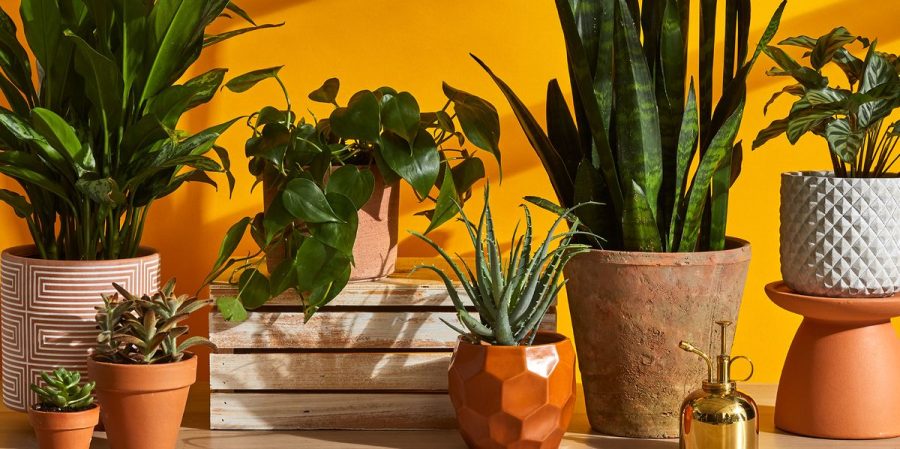9 Must-Know Tips for Houseplant Care in the Winter
Winter is known as the quiet season in the garden because most outdoor plants aren’t doing much. It’s the same for your indoor garden. Of course, your houseplants don’t have to endure snow and chilly winds whipping across the landscape. Yet, growing conditions in your home do change in several subtle ways during the colder, darker months of the year. You’ll need to adjust how you care for your houseplants in winter to keep them healthy and thriving. Use these tips to ensure your leafy friends continue to fill your home with their lushness and natural beauty through the depths of winter.
:max_bytes(150000):strip_icc()/houseplants-inside-during-winter-ea434732748e4be2ac51a9883aee3623.jpg)
1. Cut back on watering.
“Winter means less light, and generally speaking, less light means less water,” says Erin Marino from The Sill. The more sunlight a plant receives, the thirstier it will be over time, Marino explains. With limited sunlight in winter, plants use less water than they do when they are actively growing in spring and summer. “A plant that you watered every week in summer might now prefer to go two weeks without water,” Marino says.
Instead of following a schedule, it’s better to check how the potting mix feels before watering. Poke your finger at least an inch into the soil. If it’s dry, water the plant thoroughly. If it’s moist, wait a couple more days and check the soil again. If you’d rather not get your fingers dirty, use a moisture meter. “Remember, it’s easier to add water than to remove it! So, lean toward the side of underwatering if you want to be extra cautious,” Marino says.
2. Pay attention to sunlight.
When the sun comes up later and sets earlier, plants receive less sunlight than they did in spring and summer. If possible, you may want to move your plants closer to windows so they can take advantage of as much light as possible. Rotate pots a quarter turn each week to ensure all sides of your plants get sunlight from time to time. If boosting the light levels isn’t an option for you, most plants will be just fine. “Your inside plants will adjust to the seasonal change outside,” Marino says.
3. Don’t worry about a few dropped leaves.
“When bringing houseplants that spent the summer outside back indoors, they will likely drop some leaves,” says Marino. “This is perfectly normal, as they are adjusting to the lower light levels of being indoors.” If your plants stay inside year-round, a small amount of leaf drop coming into winter is normal, as well, Marino says. Leaf drop due to winter is the houseplant’s way of preparing for lower light levels and is nothing to worry about.
4. Avoid temperature extremes.
Regular household temperatures that you’re comfortable in are fine for most houseplants during the winter. But extreme changes in temperature, even for a short time, can cause problems. Keep plants away from cold drafts, radiators, and hot air vents. “Sudden hot or cold drafts can stress plants out, cause cold damage, or dry them to a crisp,” Marino says.
5. Pause the fertilizer.
Most houseplants rest in the winter. They tend to grow very little, if at all. Because they are not producing new leaves and stems, they don’t require fertilizer. Stop fertilizing in fall, and resume again in spring as plants receive more sunlight, spurring them to actively grow again.
6. Patrol for houseplant pests.
Winter is prime time for tiny sap-sucking insects such as aphids and scale to pop up. Spider mites are another common winter pest because they like warm, dry conditions. Turn plant leaves over and inspect their undersides every time you water. Check along stems, too. If you find any pests, try wiping them off with your fingers or an alcohol-soaked cotton ball. For large infestations, insecticidal soap ($7, The Home Depot) and neem oil are safer options for getting rid of houseplant pests.
:max_bytes(150000):strip_icc()/houseplants-on-blue-background-7d48e6e7-c03b9a09b6bb4895806dbd34107c7d7a.jpg)
7. Up the humidity.
The air inside our heated homes tends to be drier in winter months. Most houseplants, especially those originally from tropical areas of the world, grow best when humidity levels are between 40-50%, but wintertime humidity levels are typically 10-20% inside homes. A simple way to ramp up the humidity around plants is to cluster them together. Water evaporating from the potting soil, as well as water lost naturally through the leaves, will raise the relative humidity right around your plants.
Another easy method to increase humidity is to place plants on trays ($10 and up, Etsy) filled with pebbles and water. The bottoms of the pots should be above the water level to avoid root rot. As the water evaporates, it creates a more humid microclimate for your houseplants.
Test Garden Tip: Misting plants is not an effective way to increase humidity. Studies have found that misting would have to be done many times a day to raise the humidity level enough to make a difference. You’d be better off using a humidifier nearby.
8. Keep foliage clean.
Take maximum advantage of the limited wintertime sunlight that makes its way to plant leaves by clearing dust and grime from the foliage. These microfiber dusting gloves ($15, Bloomscape) come in handy for large leaves, but a damp cloth will work fine for wiping down each leaf. Or give the whole plant a quick rinse in the shower to make short work of cleaning off the foliage.
9. Resist repotting houseplants.
Plants take well to repotting when they are actively growing. That’s why spring and summer are the best times to repot houseplants. You might be tempted to get your hands in some soil and repot in the depths of winter. Doing so can shock dormant or resting houseplants, so resist the urge (and try starting some seeds to soothe your cabin fever instead).



